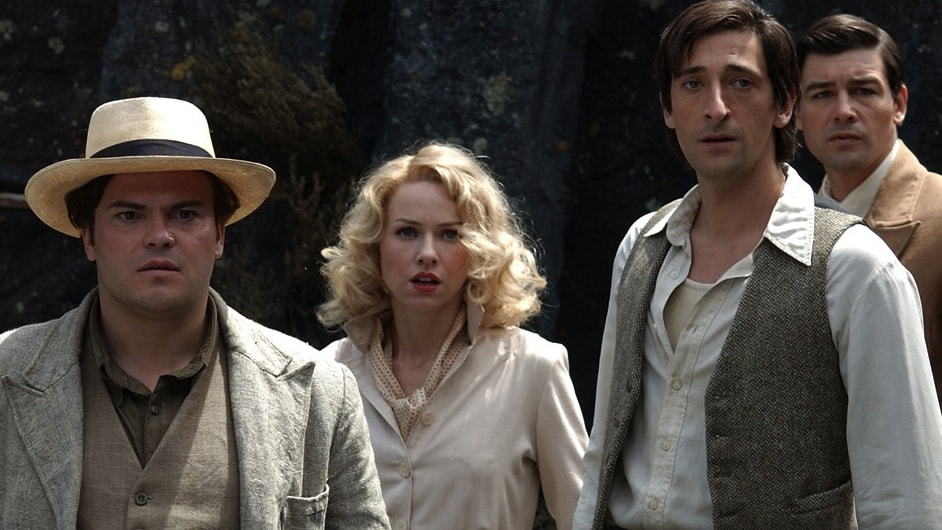His adaptation of the iconic monster movie is unlike any adaptation since the original 1933 film. At just over three hours (or three hours and twenty-ish minutes if you opt for the extended version of the film) this is no simple feat to get through. A lot of the criticism of this movie is because the first hour or so has no Skull Island, no dinosaurs, and certainly no Kong. Instead we see Ann Darrow (Naomi Watts) and Jack Driscoll (Adrien Brody) as they both find themselves lured onto a large boat by Carl Denham (Jack Black).
Once we FINALLY get to Skull Island, the film picks up and turns into an adventure unlike any other. Things quickly turn south as several sailors are killed by the natives and Ann is carried into the jungle by Kong. The survivors head off into the jungle to find her. They encounter many dangers in the ancient jungles of Skull Island, but none are quite as horrific and memorable as the infamous “insect pit” sequence.
Most films follow a standard plot structure. There is the introduction to the characters, world, and story. Then there is the inciting incident (in this case, Carl and his cast departing for the island). Next there is the rising action (all of the obstacles encountered on the island). Finally, of course, the climax (Kong breaking free in New York City), and the end of the movie. In many films, there is a moment during the rising action where all hope is lost, the characters are in their lowest state, and the audience awaits for the moment when hope will be restored and we can continue on to the climax and then resolution. In King Kong, the “insect pit” is this exact moment.
Watch the Scene:
As you could see in the scene, the crew has fallen into a pit. Kong had trapped them on a large tree that had fallen across a chasm, and then pushed it down to the bottom. Those who miraculously survived the fall find themselves in the lowest point of their lives. Carl’s camera, his whole purpose in life, is shattered. Lumpy (Andy Serkis), the ship’s cook has lost his best friend. Many other sailors have lost friends as well. Jack is the farthest he has been from finding Ann so far. In just a few moments, large, prehistoric insects begin to emerge from the nooks and crannies of the canyon walls.
Why this scene is so effective is its use of sound. The sound design in this sequence is so atmospheric and terrifying because of how minimalist it is. There is a very slight, droning, almost whining musical score in the background of the scene. This eerie musical tune is hard to pick out because the diegetic sounds, those that occur within the world of the film (the guns and bug noises for example), almost drown it out. We hear the sounds of desperate survivors fighting for their lives. We hear the crying of sailors, the groaning and grunting as they fight for their lives, the screaming as they are picked off one by one, and most terrifying of all, the inhuman, alien sounds of giant insects.
In many sequences like this, where the characters encounter a dangerous obstacle to overcome, the music would usually be louder in an attempt to create the emotion the director is aiming for. This scene uses the simplest musical sounds it can and instead relies on the sound design of the characters and the world to create the hopeless feeling that Jackson wants us to feel. We can sympathize more with Lumpy as he mourns the death of his closest friend when all we can hear is his whimpering tears. We can feel more uneasy and scared when we only hear the twisting, creaking, clicking noises of the insects as they get closer and closer. We can only cringe with absolute horror as we hear Lumpy’s screams muffled as his head and limbs are sucked into the gaping, toothy mouths of giant worms.
The sequence does not skimp on the duration of the events either. The survivors’ struggle lasts for several minutes before Bruce Baxter (Kyle Chandler), the star of Carl’s film, and Captain Englehorn (Thomas Kretschmann) return with men and guns to save the rest of the crew. At this moment, the music picks back up and the characters’, as well as we the viewers’, hope is restored.
In my opinion, this sequence is one of the highlights of the film simply for the way it creates an atmosphere that is unforgettably terrifying. Several of the action sequences in the film, such as the Kong versus two dinosaurs fight scene, a swamp monster scene (in the extended version only), and a dinosaur stampede scene help to establish Skull Island as a place where man is the bottom of the pecking order. We watch sailor after sailor die in increasingly brutal ways, but it is the least energetic and action-packed scene that ends up burned into the viewer’s memory. The bug pit is a masterpiece of a sequence, combining the adventure/monster movie genre with slow and quiet horror.
Works Cited:
https://youtu.be/yqi_C2vOars


 RSS Feed
RSS Feed
